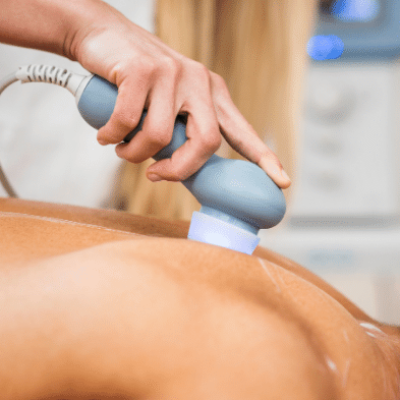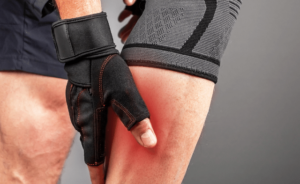Ultrasound Therapy - Downtown Vancouver

At Vancouver Physiotherapy Hub, we are committed to providing our clients with the most effective and efficient physiotherapy treatments available. That is why we incorporate ultrasound therapy into our physiotherapy sessions, so that you can get back to feeling your best as soon as possible.
For over 50 years, ultrasound therapy has been used as one of the most effective non-invasive procedures to treat inflammation caused by injuries. It is used as an effective measure of treatment for many conditions, including the following tendonitis, frozen shoulder, bursitis, carpal tunnel syndrome and more.
At Vancouver Physiotherapy Hub, we use ultrasound therapy to maximize the outcome of your treatments. Combining this with other forms of treatment, such as manual therapy, IMS, acupuncture, stretching and strengthening and exercise prescription, our physiotherapists and kinesiologists can get you back to feeling your best as quickly as possible!
Our Approach
What makes ultrasound therapy so effective is the mechanism it uses: we apply sound waves to the area of injury, which creates vibrations in the underlying tissues. This stimulates circulation in the area, which decreases inflammation and scar tissue while increasing your speed of recovery.
While ultrasound therapy is an effective method for treating acute and chronic issues, it is always most effective when it is used in a multidisciplinary approach. For the most difficult cases, Vancouver Physiotherapy Hub can recommend other types of therapies – massage therapy, acupuncture, chiropractic care and more – to treat your condition alongside physiotherapy and ultrasound. And because we are part of Electra Health, accessing these complementary treatments is easy!


What Can I Expect From My Session?
At your first appointment, you will meet with your physiotherapist. He or she will perform a comprehensive assessment, which involves assessing your body’s biomechanics through a series of range-of-motion and special tests. It also involves a detailed health history and any concerns or comments that you have.
From there, your therapist designs a plan for your session. In addition to ultrasound therapy, your session can involve manual therapy, IMS, acupuncture and stretching and strengthening exercises.
Based on the assessment and treatment session, your therapist will design a treatment plan for you. This can include further treatments, at-home stretching and strengthening exercises and exercise prescription. Your therapist may also recommend other types of modalities to accompany your ultrasound treatments. As Vancouver Physiotherapy Hub is part of Electra Health, access to these treatments is very convenient!
Frequently Asked Questions
No! When you receive ultrasound treatment, you should not feel any pain. At most, you may feel a slight warming sensation or tingling around the treated area.
Yes! If you have coverage for physiotherapy or kinesiology, ultrasound is covered. And, we provide direct billing, so it can come at no cost to you.
We do always recommend that you check with your insurance provider to verify the extent of your coverage before coming in.
The benefits of ultrasound therapy are extensive, but some of the main benefits include:
- reduced inflammation and swelling
- increased healing rate
- reduced pain
- promotes relaxation
- breaks down scar tissue
There are certain instances in which ultrasound therapy is contraindicated – meaning it would cause harm, rather than promote healing. The following are certain conditions and areas in which ultrasound therapy is not recommended:
- in people with cancer or vascular problems
- children
- during pregnancy
- near the eyes or heart
- in individuals with pacemakers
- over reproductive organs
The difference between ultrasound and other electrical therapies is primarily associated with the type of waves that are used to treat. For example, low-level laser uses light waves to promote healing, while shockwave uses high-intensity sound waves to promote healing. Shockwave has a level of discomfort than the other two.
Because they all provide a similar end-goal, which one is used is largely dependent on how your body reacts to treatment and the condition that you are seeking treatment for.
Related Resources
Welcome to the Vancouver Physiotherapy Hub, located in the vibrant heart of downtown Vancouver - a city known for its rich running community and scenic routes. While our extensive network of trails and urban pathways make Vancouver a haven for...Read More »
Muscle spasms can range from a minor annoyance to a significant barrier to daily activities, affecting individuals' quality of life. At Vancouver Physiotherapy Hub, we understand the discomfort and inconvenience that come with chronic muscle spasms and are proud to...Read More »
Dealing with back pain can be a daunting experience, affecting every aspect of your life—from your daily activities to your mental health. In your search for relief, you may have come across a variety of treatment options, with Intramuscular Stimulation...Read More »
Temporomandibular Joint (TMJ) dysfunction can significantly impact your quality of life, causing pain, discomfort, and limitations in jaw movement. At Vancouver Physiotherapy Hub, we understand the profound effects TMJ dysfunction can have on your daily activities, from eating to speaking...Read More »
Aging gracefully and maintaining independence are aspirations shared by many seniors. As we age, it's natural for our bodies to undergo various changes, including a decline in muscle mass, joint flexibility, and overall mobility. These changes can sometimes lead to...Read More »
Tennis elbow, known medically as lateral epicondylitis, is a common and painful condition that affects the tendons on the outer part of the elbow. Despite its name, tennis elbow isn't exclusive to tennis players; it can affect anyone who engages...Read More »
Rehabilitation from musculoskeletal injuries or chronic pain often requires a multi-faceted approach that goes beyond traditional treatments. In recent years, the combination of Intramuscular Stimulation (IMS) and exercise therapy has emerged as a powerful and synergistic approach to rehabilitation.
Have you ever experienced persistent musculoskeletal pain, discomfort, or postural issues that seem to defy conventional treatment methods?
In a vibrant city like Vancouver, residents lead active lives, but they may also face musculoskeletal challenges and pain due to various factors. Fortunately, Intramuscular Stimulation (IMS) is a highly effective physiotherapy technique that can provide relief from pain and...Read More »
Living in a bustling city like Vancouver has its many perks, but it can also bring its fair share of stress and anxiety. The fast pace of urban life, long work hours, and the demands of daily living can take...Read More »
What Our Clients Say About Us
Google Reviews










